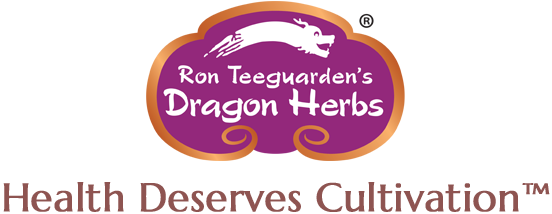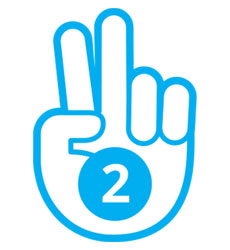Call Our Herbalists
Herbal Consultations
Yin and Yang
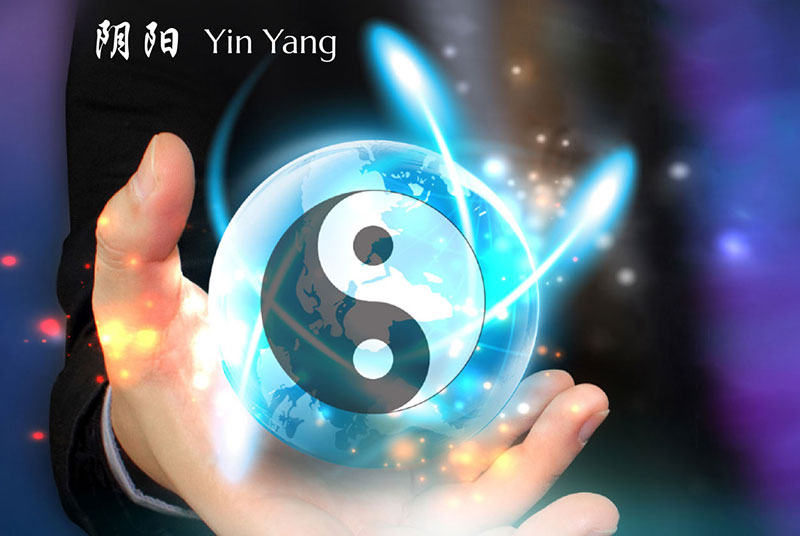 The Basis of Your Life and Health
The Basis of Your Life and Health
Chinese health practice, at every level, is based on the Principle of Yin and Yang, also known as the Great Principle. This principle asserts that everything and every function in the universe has two poles, just as a coin has two sides, a full day has night and day, and a year has summer and winter. There are no exceptions. Life itself is entirely a matter of Yin and Yang forces working together, maintaining dynamic balance (scientists call it homeostasis) on the microscopic scale and on the macroscopic scale.
We all go through birth, aging, sickness and death during our lifetime. Life is the temporary union of the yin and yang energies. Aging is the cyclical change and gradual decline of these two energies. Sickness is the prolonged imbalances of Yin and Yang. Death is the separation of the Yin-Yang union.
Life cultivation (the art of glowing health) is rooted in cultivating the balance of Yin and Yang.
The Yin-Yang principle gives you a crystal ball through which you can see simplicity beneath complexity, spot patterns among randomness and connect dots seemingly unrelated otherwise. This way of seeing paradoxical qualities can lead to a unified understanding of humankind, things and nature that is eternally insightful and practical. It provides insight into the past and the future, and helps you enjoy or cope with the present, allowing you to thrive and succeed.
|
1. Yin and Yang Are Opposing Forces Within One Integrated Whole
Yin and Yang are opposing forces, and they always exist together, though at any one moment one will usually be dominant over the other.
Yin is defined as the part of the cycle in which energy is being accumulated, assimilated and stored for later use. Yang is defined as the part of the cycle in which energy is being expended in order to create a manifest action. Thus Yin is often associated with rest, receptivity and quietude, while Yang is associated with action, expansion, expression and movement.
The world is made up of endless pairs, like two sides of a coin. There is no such thing as a one-sided coin, nor is there a one-sided process anywhere in the body.
Traditional Yin-Yang dichotomies provide a solid basis for seeing the world through the prism of Yin and Yang. Here are some of the most important dichotomies.
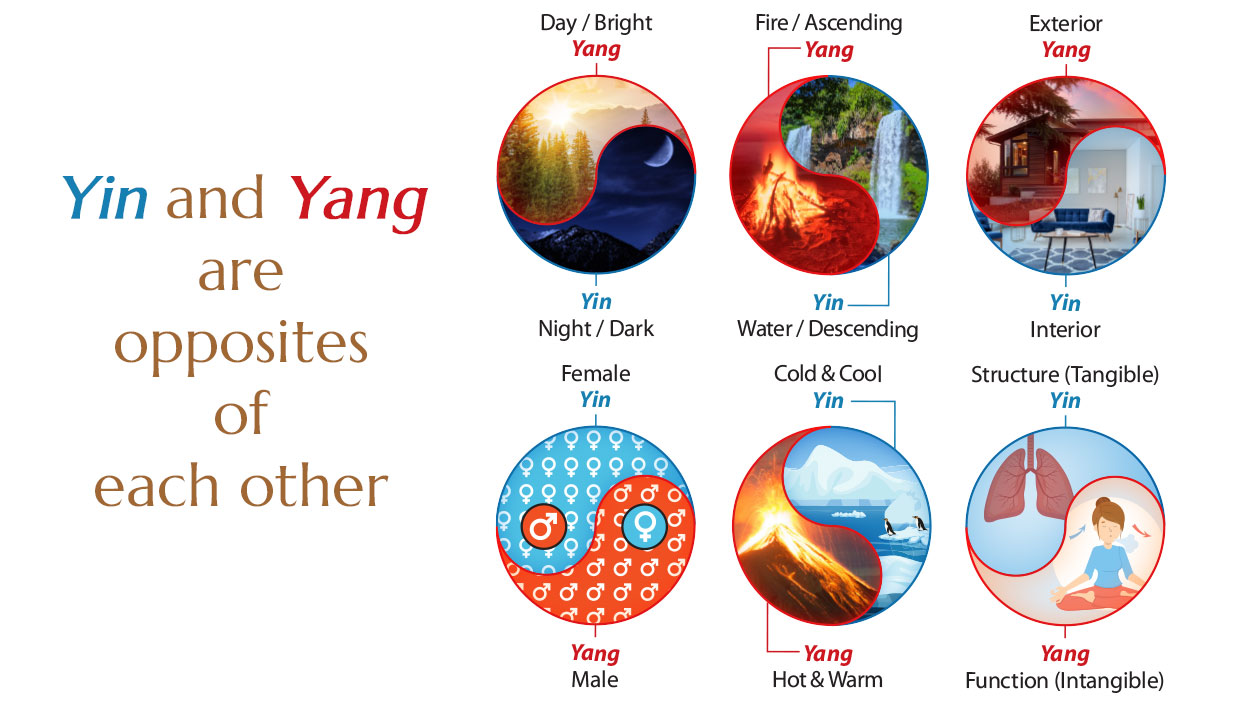
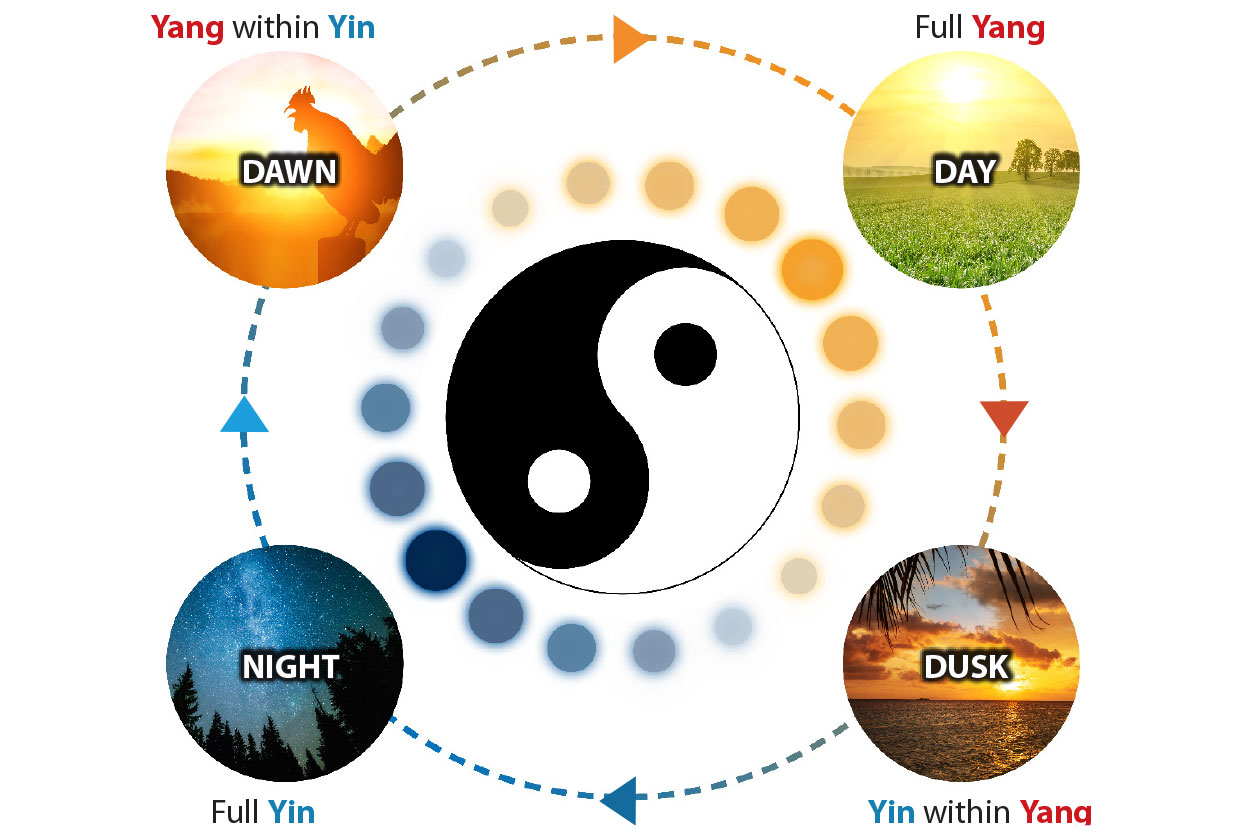
2. The Cyclical Nature of Yin and Yang
Everything changes cyclically. Cycles can be most easily understood by recognizing the rhythmic shifting from one pole to its opposite. Yin cannot last forever, and neither can Yang. Eventually Yang turns into Yin, and Yin turns into Yang.
3. The Dynamic Balance Between Yin and Yang
Yang and Yin oscillate – that is a law of nature. Progression of one force will take place as the other regresses. And then the phases reverse. This cyclic movement and change results in the maintenance of a harmonious, properly balanced healthy whole. It maintains balance (homeostasis) and order in any system, physical or living, or even psychological. Understanding this allows you to have a grip on everything happening around you and within you. Life no longer appears to be an infinite set of random actions.
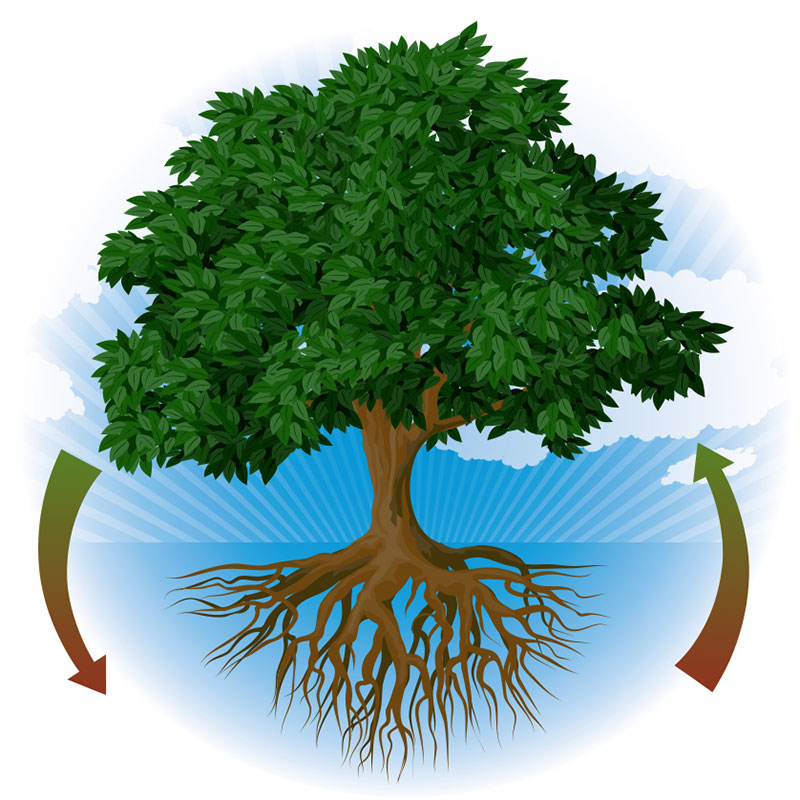
4. Yin and Yang Are Interdependent
Yin supplies Yang, Yang manifest Yin. There is no Yin without Yang. There is no Yang without Yin.
Take how we process information as an example. The phase of observing, listening, learning (information input) is Yin while talking, teaching, writing, composing, painting (information output) is a Yang phase. To output anything of meaning and value requires a lot of upfront study, research and accumulation of knowledge first. Skipping that Yin phase will lead to a product lacking in substance and facts. On the other hand, endless learning and listening without an outlet for self-expression or creative expression can lead to stagnation of Liver Qi, which can manifest as frustration and even anger.
Without the underground roots (Yin), the leaves and stems above the ground (Yang) cannot flourish. And the roots need the leaves to absorb the sunlight and carbon dioxide to produce sugar and complete the photo synthesis.
5. The Relativity of Yin and Yang
It is always important to remember that Yin and Yang are relative terms. Something can be Yang when compared to something that is more passive, but it could be viewed as Yin when compared to something more active.
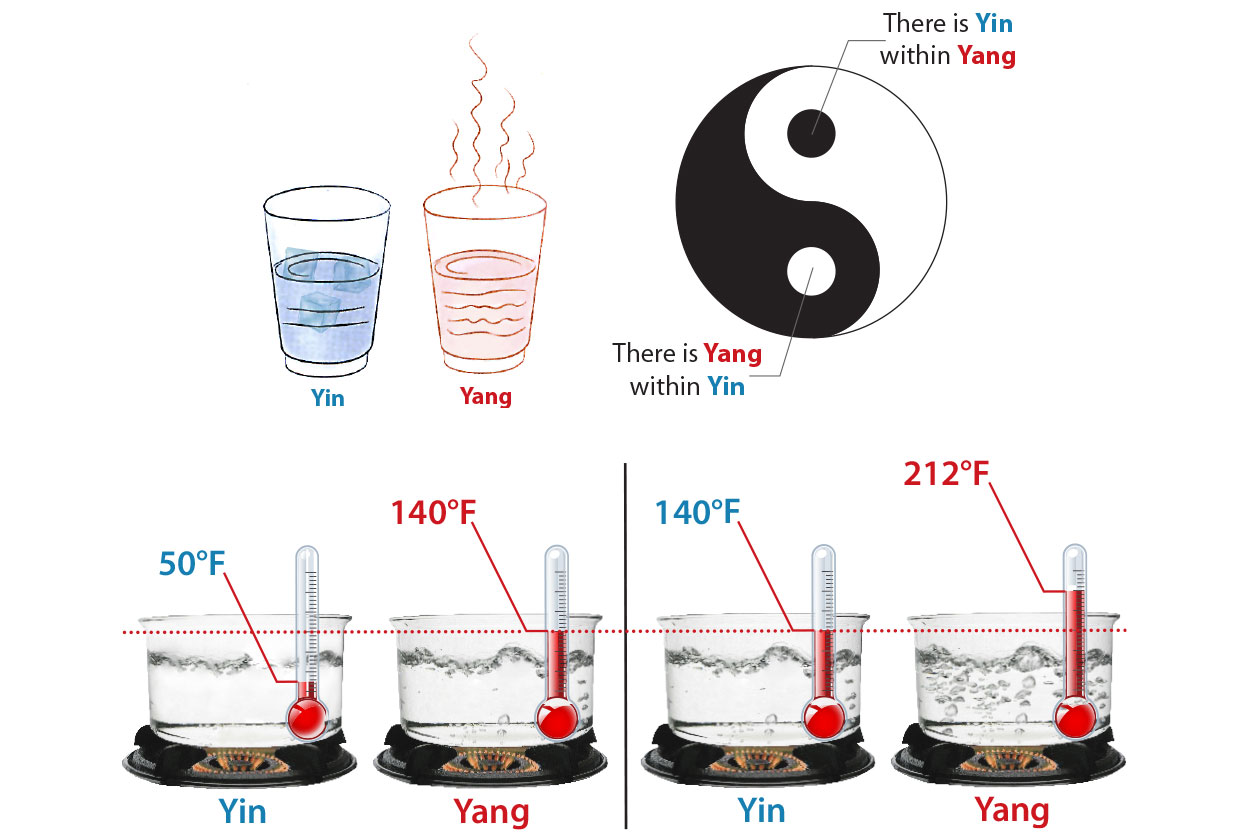
Yin and Yang are relative. 140ºF water is Yang compared to 50ºF water, but it is Yin compared to 212ºF boiling water.
Sleeping is a Yin function while being awake is a Yang function. But we are not dead when we sleep – there is still movement and dreaming – that is the “Yang inside the Yin.” Being awake is a Yang function, but we still must rest and accumulate energy while we are awake – that is the “Yin within the Yang.” Men and women both have Yin and Yang aspects. In general, men are more Yang than women. However, the opposite can be true as there are many women who are much more Yang than many men.
Yin and Yang of the Body
In the Chinese health system, the Yin-Yang principle is applied to the body’s structure and function and provides profound insights and practical guidance as to how one can best cultivate her/his life to its fullest potentials. All five aspects of the Yin-Yang relationship can be applied to any established yin-yang pairs.
Here are some bodily dichotomies – pairs of opposing structures and functions that are front and back of the same dynamic with the more important ones explained in further details:
Yin |
Yang |
|
Stillness, Quietude |
Movement, Restlessness |
|
Deficiency |
Excess |
|
Descending |
Rising |
|
Fertility |
Potency |
|
Blood, Bodily Fluid |
Qi |
|
Asleep |
Awake |
|
Dull-minded |
Alert |
|
Rest |
Work |
|
Parasympathetic nervous system |
Sympathetic nervous system |
|
Soft (Not Condensed) |
Hard (Condensed) |
|
Body coolness |
Body heat |
|
Moisture |
Dryness |
Water and Fire
Of all the dichotomies, the Yin-Yang relationship of Water and Fire are of the most profound importance in our lives.
Water represents the Yin of the body, especially as the Yin is stored in the Kidneys and related tissues as Jing, the primordial stored Yin. Fire represents the primal Yang functions of the body and mind. Water and Fire being opposites, they can control each other. The Chinese health system sees the human body as a microcosm. In the earth’s eco system, two opposing forces, the sun (Fire) and the ocean (Water), create a water cycle that provides the foundation for all life on earth. The Fire-Water (Heart-Kidney) union inside our body is also foundational to all Organs’ nourishment and functioning, such as ensuring our body temperature remains constant at 98.6° irrespective of the external temperature (within limits).
We are born with these two forces in profound balance. As we age, however, the Water force gradually becomes depleted and starts to shrink, while the Fire force tends to fl air up and expand. This is the traditional Chinese way of explaining “inflammaging,” the general tendency as we grow older to become more dehydrated and inflamed.
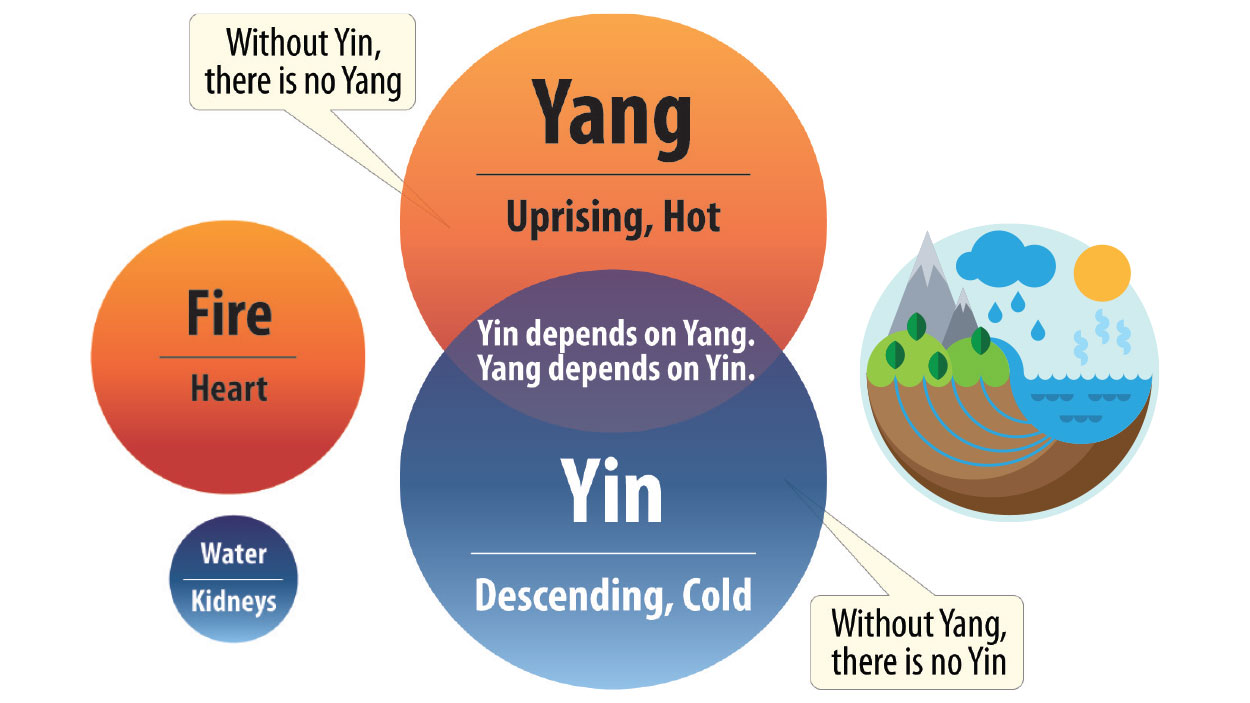
The Heart-Kidneys (Fire-Water) union is as foundational to the human body as the union of Sun-Ocean (Fire-Water) is to the earth’s ecosystem.
There are powerful, yet very safe, herbs that can be taken throughout one’s life as supplements to maintain and enhance the Water force and to control the expansion of the Fire force. You never want to eliminate Fire because Fire is the primal vitality of our life, but what is great in the correct amount can harm us when it grows uncontrollably out of balance. Tonic Herbs that support (tonify) the Water (Kidney) include He Shou Wu root, Schizandra berry, Goji berry, Dendrobium stem, Rehmannia root, Asparagus root, Ophiopogon root and others. Herbs that control Fire force, but don’t squelch it, include Salvia root, Ophiopogon root and Chinese Asparagus root, Ilex root and others.
Yin and Yang Organs
Some organs are primarily Yin and some are primarily Yang. Yin organs, by definition, store pure essences resulting from the process of transformation carried out by the Yang organs. The Yang organs are constantly digesting, filling and emptying, transforming, separating and excreting food-derived materials to produce Qi and eliminate waste. The Yin organs store the vital substances, Qi, Blood and body fluids. There are five primary Yin organs and five primary Yang organs, plus two “organs” that are composite functional systems. The Yin and Yang organs are paired either physically or energetically.
Yin Organs |
Yang Organs |
|
Kidney |
Bladded |
|
Liver |
Gall Bladder |
|
Heart |
Small Intestine |
|
Spleen/Pancreas |
Stomach |
|
Lungs |
Large Intestine |
Yin and Yang of Organ Structure and Functions
Though some organs are described above as primarily Yin or Yang, according to the Great Principle, these categorizations are relative. Each Organ contains a Yin aspect and a Yang aspect. The structure of an organ and its physical substances (Jing, blood, fluids) correspond to Yin. The functions of the organ and the actions of its released substances correspond to Yang. For example, the Liver stores blood (Yin) but also controls the flow of Qi throughout the body (Yang).
Body Heat (Yang) and Body Coolness (Yin)
Generally, body warmth is a sign of Yang activity. A person who always feels warm or who is not easily chilled is likely to be more Yang. On the other hand, a person who feels cold to the touch and often feels chilled is likely to be less Yang and more Yin. So feeling cold can either be due to an excess of Yin or a deficiency of Yang. Likewise are person can be hot because of an excess of Yang energy or from a deficiency of Yin energy. It often takes a professional to make the determination. Once the nature of a body temperature imbalance is understood, counter measures may be taken to re-establish a healthy body temperature balance. Tonic herbs and food all have a temperature factor: hot, warm, neutral, cool and cold. Appropriate herbs can be taken that support body temperature homeostasis. You may even take certain herbs during an extreme weather condition to help maintain your temperature. For example: Gynostemma leaf or American Ginseng help to cool the body in hot weather. Cinnamon bark, Red Ginseng or Astragalus root help warm the body in cold weather. There are many adjustments you can make by using specific herbs and formulas.
Body Moisture (Yin) and Dryness (Yang)
A fundamental dichotomy of our normal life that we can all observe is the fluid balance we experience both inside our body and on the surface. Skin can be dry, supple due to proper hydration, or overly wet due to excessive perspiration. We can produce too much saliva or not enough, or we can produce just the right amount at the right time. We can produce too little tears or too much tears, or our body can get it just right. The same goes for vaginal fluids, mucous secretions, digestive juices, and on and on. The regulation of bodily fluids is of fundamental importance in how we function, how we age, how we perform, and how we feel. Again, the body takes care of fluid balance automatically, but the process can go awry. In that case, herbs can play a significant role in reestablishing fluid balance, overall and in specific places. The herbs Schizandra, American Ginseng, Asian Ginseng, Dendrobium and Goji are famous for helping moisten the body during dry weather, while Poria mushroom and Atractylodes root help reduce excess fluids during damp weather.
Balance is Achieved Through Regulating Yin and Yang
It is impossible for a human, or any living being, to consciously regulate all the Yin and Yang functions of their body on a practical level. The body does that for us. Our bodies have evolved over tens of thousands of years to maintain balances on macro- and microlevels. There are millions of Yin-Yang activities going on every moment, and these activities are all miraculously regulated. It is because of these mechanisms that our body temperature stays stable, that our heart rate is steady except when stressed (and even then, within limits), that we wake and sleep in a daily rhythm, that we eat and exercise in a rhythm. At the cellular level we have thousands of molecules whose only function is to regulate the functional dynamics of other chemicals. All this is for the purpose of maintaining cellular homeostasis.
External climatic and environmental factors such as windy, dry, wet, hot or cold conditions can challenge our internal homeostasis. When we are in the desert heat, our body also becomes hot. When we are in the freezing alpine snow, our body also become cold. Our body has ways to adapt (adjust), but within limits. If we have enhanced adaptability, we may do much better. This is true in all aspects of our lives.
If these innate regulatory mechanisms become inaccurate or fail due to toxins, poor nutrition, wear-and-tear or simply because external challenges are beyond body’s capacity to adapt, some functions will become excessive and others deficient. Then our bodily functions lose balance and a cascade of problems arise.
Fundamentally, Chinese healthcare boils down to five primary actions:
- Support the regulatory mechanisms that maintain healthy whole-body balance
- Tonify Yang
- Tonify Yin
- Quell excess Yang
- Quell excess Yin
These actions can be precisely targeted.
Balance is achieved through regulating Yin and Yang Balance

Yin and Yang of Tonic Herbs
Tonic herbs that perform the first action are called adaptogens. These herbs can enhance the body’s self-regulating ability to maintain healthy homeostasis. They have bi-directional activity based on their bidirectional chemistry. In other words, if a function is tending toward deficiency, the adaptogen can reestablish the function to full strength. If a function is excessive, the adaptogen can calm down the excessive action. In this way they aid the body in broad ways, sometimes across many functions. The purpose of taking tonic herbs is primarily to feed our body’s innate regulatory system so that the body and mind can stay in balance even when under challenge.
These adaptogens are the most popular herbs in Chinese herbalism They promote modulation, regulation and dynamic balance. Here are some famous adaptogens: Ginseng root, Astragalus root, Schizandra berry, Gynostemma leaf, Rhodiola root, Reishi mushroom, Eleuthero “Siberian Ginseng” root, Codonopsis root, Mountain Ant, Ashwagandha root, Chaga mushroom.
Herbs that tonify Yang address issues of deficient Yang in the body. Yang building herbs include Eucommia bark, Deer Antler, Cistanche stem, Ever Young Herb, Epimedium leaf, Morinda root, Cinnamon bark and others.
Herbs that tonify Yin address issues of deficient Yin in the body. Yin building herbs include Goji berries, He Shou Wu root, Rehmannia root, Dendrobium pod and stem, Longan fruit, Zizyphus seed, and others.
If a person combines the use of Yin tonic herbs and Yang tonic herbs, these herbs will work together to regulate Yin and Yang. For that reason, Yin and Yang tonic herbs are often combined in formulations to create bi-directional regulation while also strengthening the body. Since ancient times, this has been called “the superior herbalism.”
* Some general herbs, when added to a formula, can also help regulate functions by removing blockage and diminishing “spikes” in our energy flow. Bupleurum is a famous example.
Yin and Yang Self Analysis Test
In order to best take advantage of the Chinese tonic herbs, it is wise to determine your Yin-Yang balance. The following tables provides a few of the markers to help you assess whether you have a Yin or Yang constitution.
Yin Constitution |
Yang Constitution |
|
Thin bones and frail frame |
Large bone and sturdy frame |
|
Pale complexion |
Ruddy complexion |
|
Pale tounge |
Red tounge |
|
Weak radial pulse |
Strong radial pulse |
|
No thirst or little thirst |
Thirst |
|
Profuse pale urine |
Scanty dark urine |
|
Loose stools |
Hard stools |
|
Sleepiness |
Restlesness |
|
Chronic lingering challenges |
Acute challenges |
|
Gradual onset |
Rapid onset |
|
Likes to be covered |
Throws off cover |
|
Likes to curl up |
Likes to lie stretched out |
|
Cold limbs and body |
Hot limbs and body |
|
Like hot drinks |
Like cold drinks |
|
Sexually passive |
Sexually agressive |
|
Weak voice, dislike talking |
Loud voice, talks a lot |
|
Passive, timid, receptive, quiet nature |
Agressive, outgoing, assertive nature |
|
Pessimistic attitude |
Optimistic attitude |
|
Slow to respond |
Quick to respond |
|
A tendency toward fear, anxiety or melancholy |
A tendency toward risk taking, easily angered, a fiery disposition |
This educational material is provided under freedom of speech for your information only. It is not intended to substitute for the medical expertise and advice of your health practitioners from whom we encourage you to seek advice about treatment or care.
These statements have not been evaluated by the Food and Drug Administraton. This product is not intended to diagnose, treat, cure, or prevent any disease.
